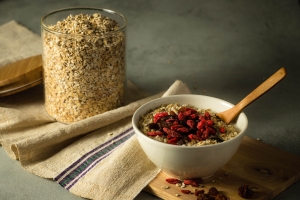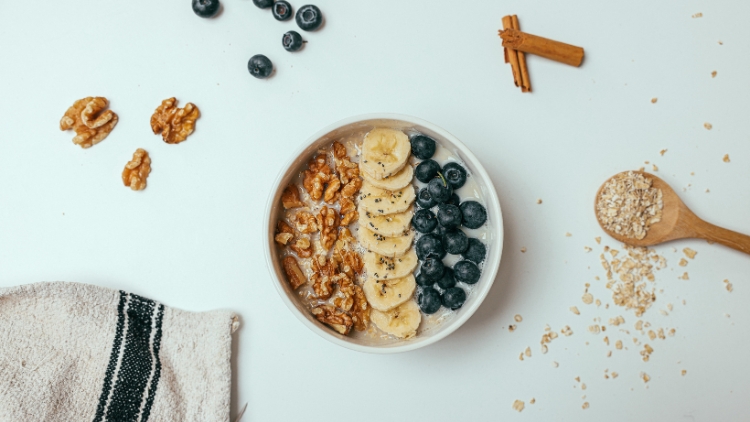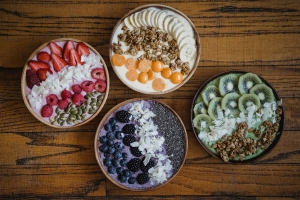Can you really shed those stubborn pounds in just one week? It sounds almost too good to be true, right? Well, get ready to dive into the world of the 7-day oatmeal diet, a plan that promises to help you lose up to 10 pounds in a single week. But before you dismiss it as another fad diet, let’s explore the science behind this seemingly simple approach and discover how oatmeal, a humble breakfast staple, can become your secret weapon for rapid weight loss.
The Power of Oatmeal
Oatmeal, a whole grain powerhouse, is packed with fiber, protein, vitamins, and minerals. It’s the ultimate comfort food that also happens to be incredibly good for you. But how does this translate to weight loss?
High Fiber Content
Oatmeal’s high fiber content is a key player in this weight loss journey. Fiber works its magic by promoting a feeling of fullness, preventing those mid-morning or afternoon cravings that often lead to unhealthy snacking. When you feel satisfied after a meal, you’re less likely to overeat, which naturally leads to consuming fewer calories overall.
Low Calorie Density
Another advantage of oatmeal lies in its low calorie density. This means you can enjoy a hearty bowl of oatmeal without consuming a large number of calories. It’s a win-win situation – you get to eat a satisfying portion while keeping your calorie intake in check.
Fat-Blocking Abilities
But that’s not all. The fiber in oatmeal also has a unique ability to bind to fat in the intestine, preventing its absorption. This means that some of the fat you consume is actually excreted from your body, further contributing to your weight loss efforts.
The 7-Day Oatmeal Diet Plan
This diet plan revolves around the strategic inclusion of oatmeal in your daily meals. It’s a balanced, calorie-controlled approach that involves three distinct phases:
Phase 1: Oatmeal Overload (Days 1-2)
In this initial phase, you’ll be incorporating oatmeal into three meals a day. Think of it as an oatmeal immersion program. This helps kickstart your weight loss journey by maximizing the benefits of oatmeal’s fiber and low calorie density.
Phase 2: Transitioning to Balance (Days 3-4)
As you move into phase 2, you’ll gradually reduce your oatmeal intake to two meals a day. This allows for more dietary variety while still maintaining the momentum of your weight loss progress.
Phase 3: Maintaining Your Success (Days 5-7)
In the final phase, you’ll continue to enjoy oatmeal for at least one meal a day. This helps solidify your new eating habits and ensures long-term weight management.
This structured approach not only promotes weight loss but also helps you develop a sustainable relationship with food, setting the stage for lasting healthy habits.
A Sample 7-Day Oatmeal Diet Meal Plan
To give you a clearer picture of what this diet looks like in practice, let’s delve into a sample meal plan for each day of the week. Remember, this is just a template, and you can adjust it based on your preferences and dietary needs.
Day 1
- Breakfast: 1 cup Coffee or tea, ½ cup Oatmeal, ½ cup Skimmed milk, 1Tbsp Raisins, ½ Tbsp Cinnamon
- Morning Snack: ½ cup Blueberries
- Lunch: 1 banana, ½ cup Oatmeal, 1/2 cup Low-fat yogurt
- Afternoon Snack: ½ cup Raw vegetable sticks
- Dinner: 4 oz Grilled chicken breast, Large green salad, ½ cup Oatmeal
- Evening Snack: Sugar-free pudding
Day 2
- Breakfast: 1cup Coffee or tea, ½ cup Oatmeal, ½ cup Skim milk, 1 Tbsp Raisins, ½ Tbsp Cinnamon
- Morning Snack: ½ cup Blueberries
- Lunch: 1 banana, ½ cup Oatmeal, 1/2 cup Low-fat yogurt
- Afternoon Snack: ½ cup Raw vegetable sticks
- Dinner: ½ cup Oatmeal, 4 oz Grilled chicken breast, Large green salad
- Evening Snack: Sugar-free pudding
Day 3
- Breakfast: 1 cup Coffee or tea, ½ cup Oatmeal, ½ cup Skim milk or milk substitute, 1 Tbsp Dried cranberries, ½ Tbsp Cinnamon
- Morning Snack: 1 Medium Apple
- Lunch: 1 cup Strawberries, ½ cup Oatmeal, 1/2 cup Low-fat yogurt
- Afternoon Snack: Handful of almonds
- Dinner: 4 oz Broiled fish fillet, 1 cup Broccoli, 1 cup Wild rice pilaf
- Evening Snack: 1 cup Celery sticks
Day 4
- Breakfast: 1 banana, 1 cup Coffee or tea, ½ cup Oatmeal, ½ cup Skim milk or milk substitute, ½ Tbsp Vanilla
- Morning Snack: 2 small kiwi fruit
- Lunch: ½ cup Oatmeal, ½ cup Skim milk or milk substitute, 1/4 cup Walnuts, 1 Tbsp Cinnamon
- Afternoon Snack: 1 Apple
- Dinner: 4 oz Lean turkey burger, 1 whole wheat bun, 1 cup Baked zucchini fries
- Evening Snack: 1 cup Sugar-free jello
Day 5
- Breakfast: 1 cup Coffee or tea, ½ cup Oatmeal, ½ cup Non-fat Greek yogurt, 1 cup Blueberries, 1/4 Tbsp Nutmeg
- Morning Snack: A handful of almonds
- Lunch: ½ cup Oatmeal, ½ cup Skim milk or milk substitute, 1/2 cup Dried cranberries, 1 Tbsp Cinnamon
- Afternoon Snack: 1 Banana
- Dinner: 4 oz Lean sirloin steak, 3 cups Garden salad, 2 Tbsp Lite salad dressing
- Evening Snack: 1 Orange
Day 6 – Day 7
- Breakfast: 1 cup Coffee or tea, ½ cup Oatmeal, ½ cup Skim milk or milk substitute, ½ cup Raisins, ½ cup Dried plums
- Morning Snack: 1 Apple
- Lunch: ½ cup Oatmeal, ½ cup Vanilla nonfat yogurt, 1/4 cup Walnuts
- Afternoon Snack: 1 Tbsp Peanut butter, 4 celery sticks
- Dinner: 2 cups Mixed vegetables, 1 light chicken soup
- Evening Snack: 1/2 cup Sugar-free pudding
This meal plan provides a good balance of nutrients while keeping your calorie intake in check. Feel free to experiment with different fruits, vegetables, and lean protein sources to keep your meals interesting and enjoyable.
Making the Oatmeal Diet Work for You
While the sample meal plan provides a solid foundation, it’s essential to personalize the diet to fit your individual needs and preferences. Here are a few tips to help you maximize your success:
1. Choose Your Oats Wisely
Not all oatmeal is created equal. Opt for whole grain oats or steel-cut oats over instant varieties. These less processed options retain more of their natural fiber and nutrients, keeping you fuller for longer and providing sustained energy throughout the day.
2. Spice Up Your Oatmeal
Let’s be honest, plain oatmeal can get boring. Don’t be afraid to experiment with different flavors and toppings to keep your taste buds excited. Add a dash of cinnamon, a sprinkle of nutmeg, or a handful of berries for a burst of flavor and antioxidants. You can also try adding a dollop of Greek yogurt or a drizzle of honey for extra protein and sweetness.
3. Hydration is Key
Drinking plenty of water throughout the day is crucial for any weight loss plan, and the oatmeal diet is no exception. Water helps to flush out toxins, keeps you feeling full, and aids in digestion. Aim for at least 8 glasses of water per day, and consider adding herbal teas or infused water for variety.
4. Listen to Your Body
Pay attention to your body’s hunger cues. If you find yourself feeling hungry between meals, don’t hesitate to add a healthy snack, such as a piece of fruit or a handful of nuts. The goal is to nourish your body and avoid feeling deprived, which can lead to overeating later on.
5. Don’t Forget Exercise
While the oatmeal diet can help you lose weight through dietary changes, incorporating regular exercise can accelerate your progress and improve your overall health. Aim for at least 30 minutes of moderate-intensity exercise most days of the week. This could include brisk walking, jogging, cycling, swimming, or any activity you enjoy.
Beyond the 7 Days
The beauty of the oatmeal diet is that it’s not just a quick fix. It’s a stepping stone to a healthier lifestyle. Once you’ve completed the 7-day plan, you can continue to incorporate oatmeal into your diet regularly, along with other healthy habits you’ve developed.
Remember, sustainable weight loss is a journey, not a destination. By making gradual, lasting changes to your eating and exercise habits, you can achieve your weight loss goals and maintain a healthy weight for the long term.
A Word of Caution
While the oatmeal diet is generally safe for most people, it’s always a good idea to consult with your doctor or a registered dietitian before starting any new diet plan, especially if you have any underlying health conditions.
It’s also important to note that rapid weight loss may not be sustainable or healthy for everyone. Aim for a gradual and steady weight loss of 1-2 pounds per week for long-term success.
The 7-day oatmeal diet offers a promising approach to jumpstart your weight loss journey. By harnessing the power of oatmeal and incorporating healthy lifestyle habits, you can achieve your weight loss goals and embark on a path to a healthier, happier you. So why not give it a try? You might be surprised at how this humble grain can transform your body and your relationship with food.







12 Responses
This diet sounds pretty restrictive. Eating oatmeal three times a day for the first two days seems like a lot! I’m worried about getting bored with it and also about missing out on other important nutrients. Is this diet really balanced enough to be healthy? And is it safe to follow long-term?
Hi Jennifer, thanks for your comment! You’re right to question the restrictiveness of any diet. Eating oatmeal three times a day is only for the first two days of the 7-day plan, a phase designed to jumpstart the weight loss process. It’s a short-term strategy, and the diet becomes more varied in phases 2 and 3.
Regarding nutritional balance, oatmeal itself is a good source of fiber, and the meal plan includes fruits, vegetables, lean protein, and dairy or dairy substitutes to provide a range of nutrients. However, it’s important to note that this 7-day plan is a short-term approach. It is essential that you supplement this diet with the necessary vitamins and minerals that you need. For instance, you can take multivitamins to make up for the nutrients you are not getting.
It is crucial to listen to your body. If you feel any adverse effects, you should stop the diet. Also, this diet is not ideal for pregnant women and people with certain health conditions. It’s always best to consult your doctor before starting any new diet, especially one that involves significant changes to your eating habits. They can advise you on whether this diet is appropriate for you and help you make any necessary adjustments to ensure you’re meeting all your nutritional needs.
I’m intrigued by the idea of using oatmeal for weight loss, but I’m a very active person. I work out almost every day, including cardio and strength training. Will this diet provide enough energy for my workouts? And will it provide enough protein for muscle recovery and growth?
Hi Sarah, that’s a great question! It’s important to consider your activity level when starting any new diet. For someone as active as you, ensuring adequate energy and protein intake is crucial.
While oatmeal is a good source of complex carbohydrates, which provide sustained energy, the calorie level of this 7-day plan might be too low for someone with a high activity level. You might find that you need to increase your portion sizes or add extra snacks to meet your energy needs, especially on workout days.
Regarding protein, the plan does include lean protein sources like chicken, fish, and yogurt. However, if you’re engaging in regular strength training, you might need to supplement with additional protein. You could consider adding a protein shake after your workouts or incorporating more protein-rich foods into your meals, such as eggs, lean meat, or tofu. It is also important to take note of the timing of your meals. You can eat more carbs before a workout to give you energy, and more protein after a workout to help with muscle recovery.
It’s also worth noting that the “fat-blocking” claims about oatmeal, while partially true, might be a bit overstated in the context of this diet. While fiber can help reduce fat absorption to some extent, it’s not a magic bullet, and overall calorie balance still plays the primary role in weight loss.
Ultimately, it’s essential to tailor the diet to your individual needs. I’d recommend monitoring your energy levels, workout performance, and recovery closely. If you find yourself feeling sluggish or not recovering well, you’ll likely need to adjust the plan by increasing your calorie and/or protein intake. Consulting with a registered dietitian or a sports nutritionist could also be very helpful in creating a plan that supports your activity level and fitness goals. They can provide personalized recommendations to ensure you’re getting the right balance of nutrients to fuel your workouts and optimize your results.
Oatmeal for 7 days? I love oatmeal, but this sounds like a recipe for becoming a grumpy, fiber-filled monster. Will I be dreaming of pizza by day 3? Also, how am I supposed to attend my weekly wine and cheese night? Asking for a friend, obviously… 😉
Brenda, I totally get it! The first couple of days might be tough, but your body adjusts. As for your wine and cheese night, maybe just bring a small container of oatmeal and call it a ‘deconstructed cheese board’? 😂 Just kidding, moderation is key! You can plan a cheat meal for special events. Plus, think of all the money you’ll save on fancy cheeses to buy new clothes after shedding those pounds! 😉
Okay, so lose 10 pounds in a week by eating mostly oatmeal? Sounds a bit drastic, doesn’t it? I mean, what happens when I go back to eating normal food? Will I balloon back up like a Thanksgiving parade float? Also, how much does one person need to “poop”, seriously? 🤔
Ashley, that’s a valid concern! This diet is more of a kickstart, to be honest. The idea is to learn better portion control and incorporate more whole grains into your diet long-term. You gradually introduce other foods back in. And, well, about the other thing… let’s just say you’ll be very “regular.” Think of it as a cleanse! 😂 But in all seriousness, the fiber is great for your digestive health!
Oatmeal three times a day? Are you kidding me? I like oatmeal as much as the next person, but that sounds like torture! Is this diet going to turn me into a human oat-making machine? And what about variety? I’m worried I’ll be so bored I’ll end up face-planting into a pizza by day 3. Also, is this diet safe for people with diabetes?
Doris, I hear you loud and clear! The thought of oatmeal three times a day can definitely sound a bit…much. But don’t worry, it’s only for the first two days to kickstart the process. Think of it as a temporary oat-bootcamp! After that, you’ll scale back to two, then one oatmeal meal a day, with plenty of room for other delicious foods. And hey, you can get creative with your oatmeal! Think of it as a blank canvas – add spices, fruits, nuts, and seeds to keep things interesting. This diet is generally not recommended for people with diabetes, as it may be too restrictive and affect blood sugar levels. It’s crucial to consult with a doctor or registered dietitian before making any significant dietary changes, especially if you have diabetes or other health conditions. As for the pizza, well, we all have our weaknesses! This diet is about progress, not perfection. If you slip up, don’t sweat it. Just get back on track with your next meal. You got this!
Ten pounds in a week sounds amazing, but is it realistic? I’ve heard that rapid weight loss can be unhealthy and lead to yo-yo dieting. Also, I’m not a big fan of cooking. Are these meals complicated to make? And can I still have my morning coffee with cream and sugar?
Linda, you’re right to be cautious about rapid weight loss. While some people might lose up to 10 pounds on this plan, individual results can vary. It’s important to remember that sustainable weight loss is a marathon, not a sprint. This diet is more about jumpstarting your journey and developing healthier habits. As for the cooking, fear not! Most of the meals are super simple and require minimal cooking skills. Oatmeal itself is a breeze to make, and the other meals are designed to be quick and easy. You can even find pre-cooked chicken or fish to save time. And about that coffee… While black coffee is recommended, a splash of skim milk or a milk substitute should be fine. As for sugar, try weaning yourself off it gradually, or use a natural sweetener like stevia in moderation. The goal is to find a balance that works for you and your taste buds. Remember, small changes can make a big difference!